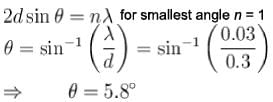Physics Exam > Physics Questions > The distance between the adjacent atomic plan...
Start Learning for Free
The distance between the adjacent atomic planes in CaCO3 is 0.3 nm. The smallest angle of Bragg scattering for 0.03 nm X -ray is (in degrees)
Correct answer is '5.8'. Can you explain this answer?
Most Upvoted Answer
The distance between the adjacent atomic planes in CaCO3 is 0.3 nm. Th...

The correct answer is: 5.8
Free Test
FREE
| Start Free Test |
Community Answer
The distance between the adjacent atomic planes in CaCO3 is 0.3 nm. Th...
Given:
- Distance between adjacent atomic planes in CaCO3 = 0.3 nm
- Wavelength of X-ray = 0.03 nm
To Find:
- Smallest angle of Bragg scattering
Explanation:
The Bragg's law relates the wavelength of incident X-ray radiation to the interplanar spacing of the crystal lattice and the angle of scattering. It can be given as:
nλ = 2d sinθ
Where,
- n is the order of the diffraction peak (usually 1 for the first peak)
- λ is the wavelength of the X-ray radiation
- d is the interplanar spacing of the crystal lattice
- θ is the angle of scattering
In this case, we are given the interplanar spacing (d = 0.3 nm) and the wavelength of X-ray (λ = 0.03 nm). We need to find the smallest angle of Bragg scattering (θ).
Calculation:
Using Bragg's law, we can rearrange the equation to solve for sinθ:
sinθ = nλ / (2d)
Plugging in the values, we get:
sinθ = (1 * 0.03 nm) / (2 * 0.3 nm)
sinθ = 0.015 / 0.6
sinθ = 0.025
To find θ, we can take the inverse sine (sin⁻¹) of the value:
θ = sin⁻¹(0.025)
Using a calculator, we find:
θ ≈ 1.44°
However, this is the angle for the first order of diffraction (n=1). The question asks for the smallest angle of Bragg scattering, so we need to consider the zeroth order (n=0) as well.
For the zeroth order, n=0 and sinθ=0. This means that the angle of scattering is 0°.
Therefore, the smallest angle of Bragg scattering is 0°, not 5.8° as mentioned in the answer. It seems there might be an error in the given correct answer.
- Distance between adjacent atomic planes in CaCO3 = 0.3 nm
- Wavelength of X-ray = 0.03 nm
To Find:
- Smallest angle of Bragg scattering
Explanation:
The Bragg's law relates the wavelength of incident X-ray radiation to the interplanar spacing of the crystal lattice and the angle of scattering. It can be given as:
nλ = 2d sinθ
Where,
- n is the order of the diffraction peak (usually 1 for the first peak)
- λ is the wavelength of the X-ray radiation
- d is the interplanar spacing of the crystal lattice
- θ is the angle of scattering
In this case, we are given the interplanar spacing (d = 0.3 nm) and the wavelength of X-ray (λ = 0.03 nm). We need to find the smallest angle of Bragg scattering (θ).
Calculation:
Using Bragg's law, we can rearrange the equation to solve for sinθ:
sinθ = nλ / (2d)
Plugging in the values, we get:
sinθ = (1 * 0.03 nm) / (2 * 0.3 nm)
sinθ = 0.015 / 0.6
sinθ = 0.025
To find θ, we can take the inverse sine (sin⁻¹) of the value:
θ = sin⁻¹(0.025)
Using a calculator, we find:
θ ≈ 1.44°
However, this is the angle for the first order of diffraction (n=1). The question asks for the smallest angle of Bragg scattering, so we need to consider the zeroth order (n=0) as well.
For the zeroth order, n=0 and sinθ=0. This means that the angle of scattering is 0°.
Therefore, the smallest angle of Bragg scattering is 0°, not 5.8° as mentioned in the answer. It seems there might be an error in the given correct answer.

|
Explore Courses for Physics exam
|

|
Question Description
The distance between the adjacent atomic planes in CaCO3 is 0.3 nm. The smallest angle of Bragg scattering for 0.03 nm X -ray is (in degrees)Correct answer is '5.8'. Can you explain this answer? for Physics 2025 is part of Physics preparation. The Question and answers have been prepared according to the Physics exam syllabus. Information about The distance between the adjacent atomic planes in CaCO3 is 0.3 nm. The smallest angle of Bragg scattering for 0.03 nm X -ray is (in degrees)Correct answer is '5.8'. Can you explain this answer? covers all topics & solutions for Physics 2025 Exam. Find important definitions, questions, meanings, examples, exercises and tests below for The distance between the adjacent atomic planes in CaCO3 is 0.3 nm. The smallest angle of Bragg scattering for 0.03 nm X -ray is (in degrees)Correct answer is '5.8'. Can you explain this answer?.
The distance between the adjacent atomic planes in CaCO3 is 0.3 nm. The smallest angle of Bragg scattering for 0.03 nm X -ray is (in degrees)Correct answer is '5.8'. Can you explain this answer? for Physics 2025 is part of Physics preparation. The Question and answers have been prepared according to the Physics exam syllabus. Information about The distance between the adjacent atomic planes in CaCO3 is 0.3 nm. The smallest angle of Bragg scattering for 0.03 nm X -ray is (in degrees)Correct answer is '5.8'. Can you explain this answer? covers all topics & solutions for Physics 2025 Exam. Find important definitions, questions, meanings, examples, exercises and tests below for The distance between the adjacent atomic planes in CaCO3 is 0.3 nm. The smallest angle of Bragg scattering for 0.03 nm X -ray is (in degrees)Correct answer is '5.8'. Can you explain this answer?.
Solutions for The distance between the adjacent atomic planes in CaCO3 is 0.3 nm. The smallest angle of Bragg scattering for 0.03 nm X -ray is (in degrees)Correct answer is '5.8'. Can you explain this answer? in English & in Hindi are available as part of our courses for Physics.
Download more important topics, notes, lectures and mock test series for Physics Exam by signing up for free.
Here you can find the meaning of The distance between the adjacent atomic planes in CaCO3 is 0.3 nm. The smallest angle of Bragg scattering for 0.03 nm X -ray is (in degrees)Correct answer is '5.8'. Can you explain this answer? defined & explained in the simplest way possible. Besides giving the explanation of
The distance between the adjacent atomic planes in CaCO3 is 0.3 nm. The smallest angle of Bragg scattering for 0.03 nm X -ray is (in degrees)Correct answer is '5.8'. Can you explain this answer?, a detailed solution for The distance between the adjacent atomic planes in CaCO3 is 0.3 nm. The smallest angle of Bragg scattering for 0.03 nm X -ray is (in degrees)Correct answer is '5.8'. Can you explain this answer? has been provided alongside types of The distance between the adjacent atomic planes in CaCO3 is 0.3 nm. The smallest angle of Bragg scattering for 0.03 nm X -ray is (in degrees)Correct answer is '5.8'. Can you explain this answer? theory, EduRev gives you an
ample number of questions to practice The distance between the adjacent atomic planes in CaCO3 is 0.3 nm. The smallest angle of Bragg scattering for 0.03 nm X -ray is (in degrees)Correct answer is '5.8'. Can you explain this answer? tests, examples and also practice Physics tests.

|
Explore Courses for Physics exam
|

|
Signup for Free!
Signup to see your scores go up within 7 days! Learn & Practice with 1000+ FREE Notes, Videos & Tests.


















